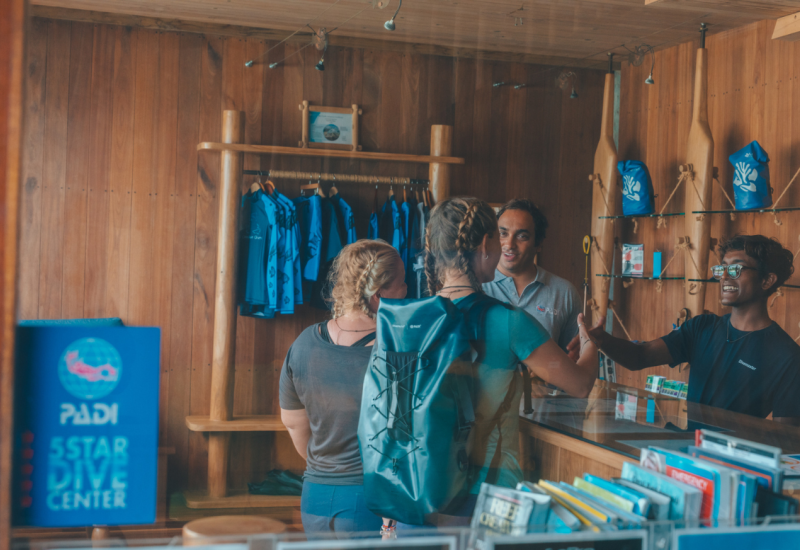Galapagos Diving with a Whale Shark Encounter
January 18, 2012
The pinnacle of Galapagos diving — and maybe the best dive in the world? — is The Arch, a small nothing of an island about ½ mile off Darwin, the northernmost island in the Galapagos. And the highlight of diving The Arch is the hammerheads.
We arrived at Darwin early this morning, enabling us to get an early start to the day. Something different, which made the three-dive day a whole lot more enjoyable. We dropped in on The Arch at 9am, on a current the tender driver described as suave.
“Suave” apparently translates to around two knots, which was strong enough that even clearing my mask was troublesome. Negative descent, I dropped quickly to a ledge sprinkled with boulders all over. There was a small wall that one of the divemasters hid behind; I stayed out in the open, but ducked behind a cropping of corals.
There were plenty of fish and turtles on the first dive: barracuda, trevally, snappers, mackerel and more. I had eyes only for the hammerheads, though, which came in singles, pairs, and finally in groups of 10 to 15. They rarely ventured near, but near enough to get a good look. There were a couple of cleaning stations a few feet away, and I’d see them pause for a few seconds then contort their bodies to eject the small cleaning fish in their gills.
The second dive was much the same, with a shallower arena that was surrounded on all sides by larger boulders. The current was even stronger, but because of the topography we weren’t as affected. We arranged ourselves on a ridge on one end, and watched as massive Galapagos sharks and silky sharks swam past. This was the best of all the hammerhead dives so far, as some swam near, but the crowning glory was the large groups that swam about 15 feet above us, like a squadron of planes off to an aerial battle.
As it has with the two days prior, these two dives were just prelude to the final. The plan for the third and final dive was to drop in on a sandy bed where a few cleaning stations were in the shallows. But the current had died to almost nothing, and when we found a spot on the reef below there wasn’t much action — a few lone hammerheads above us, a few below us. Luckily, two ventured close within the first couple of minutes, and then the reef was empty.
Yes, the massive schools of fish were still around — including a large tornado of jacks — but it was as if the show was over. Little did I know it had only just begun.
The first group of divers had buggered off a few minutes before, and ours was soon following them, drifting slowly with the current. I held back a little, as I tend to do so that I might see if a straggler comes along, when I noticed a shadow off to my right coming down off the reef top. It was a whale shark.
I turned to face the butts and fins, and screamed into my regulator to get someone’s attention — you’re not allowed to dive solo in the Galapagos and I needed someone to follow along with me after the shark, but I also wanted my group to see the shark. My buddy, Gavin, was near the front, but Peru-American International schoolteacher Steven turned around to see what the ridiculous noise was and I was off.
I eventually caught up to the shark before it swam off into the blue. It turned and came back though. By then, Steven had caught up. The whale shark made a slow turn, swam along the reef for 3 or 4 minutes, then made another turn and came back. He slowed down at this point, which was a blessing because I was huffing. If you’ve ever dived with a whale shark, you know that they look slow but they’re anything but. That massive tail creates a lot of thrust; my brain was overloaded and my lungs on fire just trying to keep up. (To make matters worse, by now the current had quickened and we were swimming against it.) The shark swam with us for a couple minutes then disappeared into the blue. A 10-minute encounter that felt like it lasted 10 hours. Whale sharks are just that special.
We drifted along with the current, into the shallow channel, and popped up 37 minutes later. It was Steven’s first whale shark encounter. My fourth or fifth, but the day I tire of seeing whale sharks is the day I give up diving.
Peter Hughes is regaling us with old Galapagos stories now; we’re all resting up before dinner. It’s been a great day at Darwin, couldn’t really get better. Just hoping for a signature wall of hammerheads tomorrow. We have two more dives to get it before heading back for a p.m. dive on Wolf, and then back south.
January 18, 2012
The pinnacle of Galapagos diving — and maybe the best dive in the world? — is The Arch, a small nothing of an island about ½ mile off Darwin, the northernmost island in the Galapagos. And the highlight of diving The Arch is the hammerheads.
We arrived at Darwin early this morning, enabling us to get an early start to the day. Something different, which made the three-dive day a whole lot more enjoyable. We dropped in on The Arch at 9am, on a current the tender driver described as suave.
“Suave” apparently translates to around two knots, which was strong enough that even clearing my mask was troublesome. Negative descent, I dropped quickly to a ledge sprinkled with boulders all over. There was a small wall that one of the divemasters hid behind; I stayed out in the open, but ducked behind a cropping of corals.
There were plenty of fish and turtles on the first dive: barracuda, trevally, snappers, mackerel and more. I had eyes only for the hammerheads, though, which came in singles, pairs, and finally in groups of 10 to 15. They rarely ventured near, but near enough to get a good look. There were a couple of cleaning stations a few feet away, and I’d see them pause for a few seconds then contort their bodies to eject the small cleaning fish in their gills.
The second dive was much the same, with a shallower arena that was surrounded on all sides by larger boulders. The current was even stronger, but because of the topography we weren’t as affected. We arranged ourselves on a ridge on one end, and watched as massive Galapagos sharks and silky sharks swam past. This was the best of all the hammerhead dives so far, as some swam near, but the crowning glory was the large groups that swam about 15 feet above us, like a squadron of planes off to an aerial battle.
As it has with the two days prior, these two dives were just prelude to the final. The plan for the third and final dive was to drop in on a sandy bed where a few cleaning stations were in the shallows. But the current had died to almost nothing, and when we found a spot on the reef below there wasn’t much action — a few lone hammerheads above us, a few below us. Luckily, two ventured close within the first couple of minutes, and then the reef was empty.
Yes, the massive schools of fish were still around — including a large tornado of jacks — but it was as if the show was over. Little did I know it had only just begun.
The first group of divers had buggered off a few minutes before, and ours was soon following them, drifting slowly with the current. I held back a little, as I tend to do so that I might see if a straggler comes along, when I noticed a shadow off to my right coming down off the reef top. It was a whale shark.
I turned to face the butts and fins, and screamed into my regulator to get someone’s attention — you’re not allowed to dive solo in the Galapagos and I needed someone to follow along with me after the shark, but I also wanted my group to see the shark. My buddy, Gavin, was near the front, but Peru-American International schoolteacher Steven turned around to see what the ridiculous noise was and I was off.
I eventually caught up to the shark before it swam off into the blue. It turned and came back though. By then, Steven had caught up. The whale shark made a slow turn, swam along the reef for 3 or 4 minutes, then made another turn and came back. He slowed down at this point, which was a blessing because I was huffing. If you’ve ever dived with a whale shark, you know that they look slow but they’re anything but. That massive tail creates a lot of thrust; my brain was overloaded and my lungs on fire just trying to keep up. (To make matters worse, by now the current had quickened and we were swimming against it.) The shark swam with us for a couple minutes then disappeared into the blue. A 10-minute encounter that felt like it lasted 10 hours. Whale sharks are just that special.
We drifted along with the current, into the shallow channel, and popped up 37 minutes later. It was Steven’s first whale shark encounter. My fourth or fifth, but the day I tire of seeing whale sharks is the day I give up diving.
Peter Hughes is regaling us with old Galapagos stories now; we’re all resting up before dinner. It’s been a great day at Darwin, couldn’t really get better. Just hoping for a signature wall of hammerheads tomorrow. We have two more dives to get it before heading back for a p.m. dive on Wolf, and then back south.










